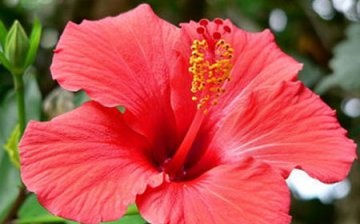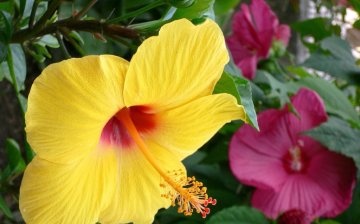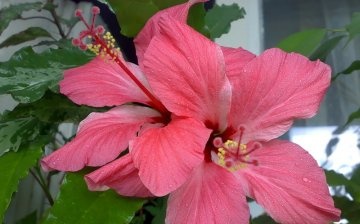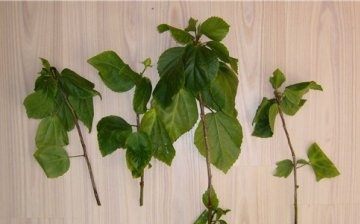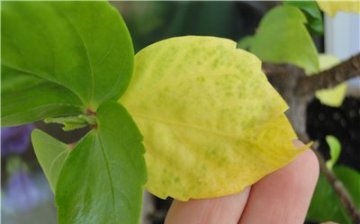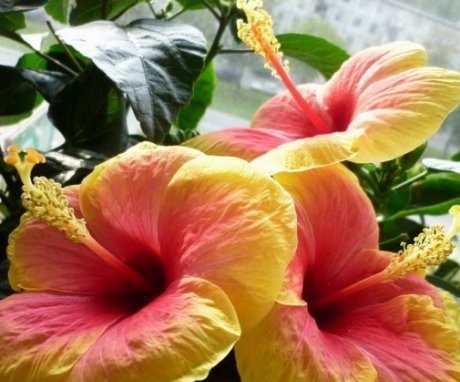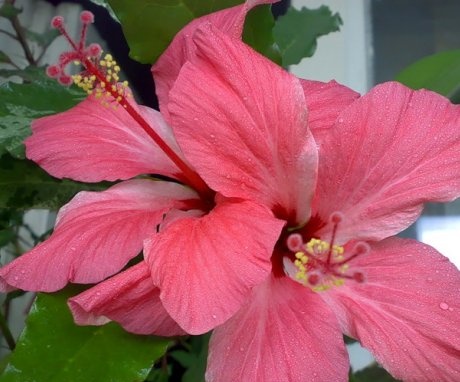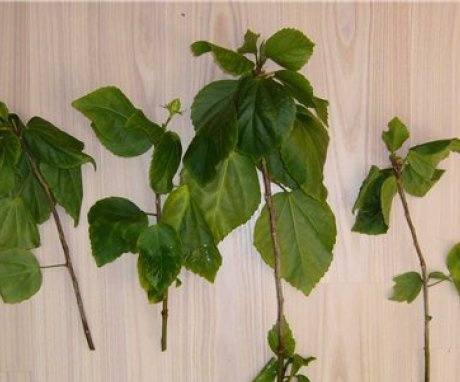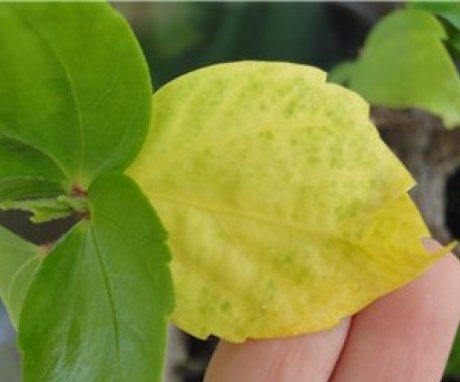Hibiscus care at home and basic growing rules
Hibiscus - one of the most common indoor plants, it attracts with fast growth, pleasant appearance and unpretentiousness. It can be grown on any windowsill, it is undemanding to watering and lighting, but with improper care it will not bloom. But if you organize the right care hibiscus at home, Chinese rose will delight its owner with bright and very beautiful buds. Which is the best variety to choose and how to provide good growth conditions for your hibiscus?
Content:
- General view of the plant and its properties
- Varieties and varieties of hibiscus
- Basic rules for caring for hibiscus
- Breeding options for hibiscus
- Possible difficulties in growing hibiscus
General view of the plant and its properties
Hibiscus comes from the Malvaceae family, Asia Minor is considered its homeland. In the wild, it is found in Korea and China, its name can be translated as "a flower for beautiful ladies." It has been known for a very long time, and because of its beautiful buds, it has always been highly prized by plant lovers.
Hibiscus characteristic:
- Hibiscus is evergreen bush, in natural conditions, its growth can reach three meters.
- It has a branched crown, its bark is gray.
- One of its features is the very flexible branches that are difficult to break.
- In nature, hibiscus blooms from June to September, but in an apartment it can bloom constantly, if you provide constant feeding and good conditions for the growth of new shoots.
- Each flower pleases its owners with its beauty for only one day, and after full opening, it quickly begins to fade. But in comfortable conditions, hibiscus flowers are plentiful, so its branches will not be empty. This is a great decoration for a room, and hibiscus can grow for a very long time.
It has been cultivated as a cultivated plant for a very long time, and it has become widespread in many cultures. It owes its popularity not only to beautiful flowers. According to legend, the bud accidentally fell into the tea for a tired traveler, and the drink filled him with vitality and vigor.
Today, the famous hibiscus tea is made from dried fruits of some types of hibiscus, which has an unusual taste and invigorating properties.
In addition, there are several edible varieties whose leaves and shoots can be used as vegetables in cooking.
Varieties and varieties of hibiscus
The hibiscus family has several hundred species, and not all of them are suitable for growing in an apartment. Many varieties are used to decorate and decorate garden beds, but some are just perfect for a home windowsill:
- Chinese hibiscus is considered one of the most common indoor species: it has an unusual shape of oval leaves, they have a jagged edge. Chinese hibiscus gives large flowers of a pale pink or red color, their diameter can reach 16 cm. Several varieties can be grown in the room: among them Carmine Red, Double Rose, Florida and many others.It is because of the bright flowers that they have become popular among amateur flower growers.
- Another common variety is the hybrid hibiscus. It differs from all the others in the non-standard color of the buds - they will be pale pink, large petals look very impressive. The hybrid hibiscus was formed as a result of crossing the pink, holly and red species, breeding work made it possible to create a new variety.
- The most unusual is the dissected hibiscus with irregular pinkish flowers. It features long shoots that can be used to effectively decorate flower beds. Syrian hibiscus and some other species that are more common in gardens than in rooms are also common.
Basic rules for caring for hibiscus
Hibiscus very often it is grown in apartments, but often it stands for years in uncomfortable conditions, which is why it practically does not bloom, and the crown grows extremely slowly.
Providing comfortable conditions for him will not be so difficult if you follow a few basic principles:
- Regular plentiful watering... Hibiscus does not like drought very much, and even a short break in watering can lead to yellowing and fall of the leaves, as a result of which the plant can quickly die. In extreme heat, watering is increased, in addition, it is necessary to ensure sufficient air humidity with the help of regular spraying.
- Good illumination. The best place for hibiscus is a windowsill on the sunny side of the house, since the plant will not bloom without bright lighting. It requires light all year round, so in winter, with a decrease in daylight hours, it is necessary to supplement it with correctly configured artificial lighting.
- Air temperature. The optimum temperature for a guest from warm countries is +24 degrees. In autumn and winter, the temperature can drop at least +12 degrees, otherwise the plant will freeze and begin to shed its leaves. During the summer months, the room will need to be ventilated, and the necessary humidity will have to be maintained in it.
- Top dressing... It is necessary to feed the plant once every six months, usually this time falls on September and March. During these months, you need to feed the plant once a week, complex mineral fertilizer alternates with infusion mulleindiluted 1:10. In winter, the Chinese rose requires additional potassium-phosphorus fertilizer, feeding should be done about once a month.
- The soil. Hibiscus prefers light, nutritious soils, a pH level of about 6, the soil should be close to neutral in acidity. For planting, you can purchase a ready-made soil mixture, or you can prepare a substrate yourself from leafy, sod, humus soil and sand in a ratio of 4: 3: 1: 1. In addition, ash and peat can be added, they will provide the plant with nutrients.
- An important condition for normal growth is the presence of a drainage layer. Due to abundant watering, water can stagnate, which will lead to root rot. The drainage layer will help prevent rotting and protect the root system. Transplant hibiscus will need mails every year as it grows rapidly and will need to provide adequate root space.
Breeding options for hibiscus
Hibiscus breeds cuttings and seeds, the second option is more suitable for breeding work with the aim of developing new varieties. Young shoots are chosen for cuttings; they need to be cut off in the summer months, which are periods of active growth. A stalk with several internodes is cut off, and the cut site must be immediately treated with a growth stimulant. After that, the stalk must be placed in a greenhouse or in a pot with moist soil, covered with a glass jar.
When the cuttings give roots, they are placed in pots 7-10 cm high, the soil should be rich in humus.
To accelerate growth, bone meal can be added to the soil mixture. Subsequently, the sprout is transplanted into a larger container in order to make room for the growth of the root system.
It is important to form the bush correctly. To stimulate growth, it is advisable to pinch the lower shoots and carry out regular pruning... It promotes the rapid branching of the bush, and flowers will quickly begin to appear on young shoots. The first transfer may be required within a few months after planting the cuttings. When pruning, the branches are cut to half their length, this will allow you to quickly form a beautiful crown... With such a transplant, the plant will begin to bloom in the first year.
Seed propagation is most convenient in February or early spring.
Before boarding the seeds need to be soaked for 12 hours, after which they are placed in a soil mixture consisting of sand and peat in equal proportions. The container must be covered with glass or a mini-greenhouse must be installed; the temperature in the room must be at least 25 degrees. When seedlings give 3-4 leaves, they can be dived into pots in size. Although hibiscus grows quite quickly, it begins to bloom only 3-4 years of age.
Breeding work will allow you to get an unusual hybrid plant with a non-standard shade of flowers, they can vary in size. Each grower can bring out a new interesting variety on his own windowsill.
Possible difficulties in growing hibiscus
Even if the basic conditions are met, the plant can get sick or suffer from pests: Hibiscus is afraid of aphids, spider mites and some other parasites.
In addition, a florist can face several common problems:
- The buds cannot open, they appear on the branches and fall off. Several factors can affect this at once: most often the buds fall off when there is an insufficient amount of nutrients in the soil, insufficient watering or too low light. It is also advisable to increase the temperature in the room, as this can also affect the viability of the buds.
- The plant has a lush crown with bright green leaves, but does not bloom. This state of hibiscus indicates an excess of nitrogenous compounds in the soil. Most likely, the bush was overfed with fertilizers, in addition, it does not have enough light. Top dressing for a while must be stopped, in addition, you need to try to improve the illumination.
- Falling of the lower leaves and yellowing of the crown. This most often indicates an excess of salts in the irrigation water and a lack of iron. For glaze hibiscus, it is undesirable to use plain tap water, as it is too hard. In this case, it is best to at least settle the water for several days, and it should only be at room temperature. Leaves can also turn yellow if the plant is suffering from cold - the room temperature needs to be made comfortable.
- If the leaves of a hibiscus begin to wither noticeably, most often this indicates insufficient watering or too dry indoor air. This plant is often called marsh mallow precisely because of its love of moisture, and care must be taken to ensure that it does not suffer from a lack of water. The best watering solution is filtered water fortified with iron and should not be cold.
- Spider mite infection is manifested by a white bloom on the leaves, and they begin to wilt quickly. This parasite feeds on the cell sap of the leaves, and if measures are not taken in time, the plant may die. All affected leaves must be removed - they still cannot be saved. After that, the plant is thoroughly sprayed with solutions of special insecticides, which can be purchased at a phyto-pharmacy. The spider mite quickly passes from one plant to another, so the affected hibiscus must be isolated.It is necessary to process not only the leaves, but also the soil, and after a few days the processing will have to be repeated in order to completely get rid of the parasite.
Hibiscus - a great decoration for home and office: it grows quickly and looks great in any room.
If you take care of comfortable conditions for him, he can delight with magnificent flowering almost all year round, and he can grow for a very long time. The exotic guest on the windowsill will quickly become one of your favorite plants, and the beauty of its flowers will pay off all the costs of caring for it.
More information can be found in the video.



